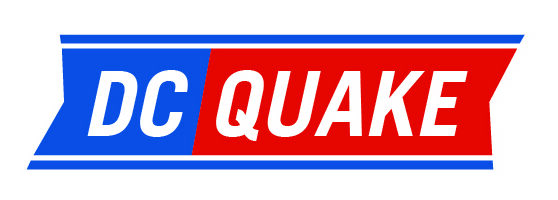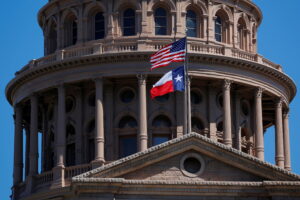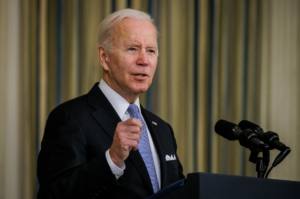Here’s what Texans need to know about the government shutdown threat in Congress
4 min read
Congressional Democrats are scrambling to stave off a potential government shutdown before Thursday’s midnight deadline.
On Monday, Senate Republicans blocked a bill extending the federal budget into December after ongoing partisan fights over increasing the federal borrowing limit.
By Tuesday evening, Senate leaders were circulating a revamped federal spending bill without the provision contested by Republicans that lifts the cap on how much the federal government can borrow. According to Politico, that bill may face a vote in the Senate as early as Wednesday.
If lawmakers on Capitol Hill fail to compromise on a government spending bill on time, federal agency offices in Texas will close and thousands of employees will be furloughed without pay.
What happens to Texas?
If Congress fails to reach a deal to fund the government, federal agencies in Texas will cease operations, and any nonessential Texas federal employees will be furloughed from their roles without pay.
With over 35,000 federal employees in 22 federal agencies in Texas who may face furloughs, Texas is third only to California and the District of Columbia as areas most affected by a shutdown, according to data from the U.S. Office of Personnel Management.
Federal services classified as essential to public safety or security, including the National Security Agency and Department of Justice, will stay in operation. According to the Committee for a Responsible Federal Budget, border protection, hospital medical care, air traffic control, law enforcement and power grid maintenance have been classified as essential services in previous shutdowns.
However, nonessential federal agencies like the U.S. National Park Service and the National Aeronautics and Space Administration will close or limit visitor services. This includes museums, historical sites and parks, including Big Bend National Park and the Johnson Space Center.
With limited staff, nonessential government procedures could stall until funding resumes. Applications for home or small-business loans, passport processing and visa applications could all face delays should a shutdown occur. Depending on the shutdown length, federal assistance like food stamps and Social Security checks could also be impeded.
Following the most recent shutdown in December of 2018, President Donald Trump signed a bill guaranteeing automatic back pay to federal employees once operations resume. The Congressional Budget Office estimated the 35-day shutdown — the longest in U.S. history — cost the U.S. economy around $3 billion.
COVID-19 response
Although funding lapses are an annual concern in Washington during appropriations season, a government shutdown during a global pandemic would be unprecedented.
The U.S. Department of Health and Human Services reported it would likely furlough 43% of its staff but noted that the department’s COVID-19 response efforts and direct public health measures would “generally proceed” under the department’s readiness plan.
This means the Food and Drug Administration will continue to operate as it relates to COVID-19, including drug authorizations, medical and drug shortages, and misconduct investigations. The National Institutes of Health will continue to support COVID-19 vaccine-related activities including drug trials and research and development.
The shutdown threat comes during a time when the highly transmissible delta variant of the coronavirus continues to spread rampantly throughout Texas, with 4 million confirmed and probable COVID-19 cases as of Monday.
Last week, White House spokesperson Jen Psaki told reporters the Biden administration is “taking every step we can to mitigate the impacts of a potential shutdown on our pandemic response, economic recovery or other priorities.”
While the U.S. Office of Management and Budget told all federal agencies to prepare for a shutdown last Thursday, the office emphasized this was a standard notification procedure.
Will this happen?
With Democrats dropping their demand to raise the debt ceiling in a standalone continuing resolution, it’s possible a shutdown will be averted. However, this will punt the problem of the national debt to later this year.
Sen. John Cornyn, R-Texas, said last week that while he expects Congress will find a solution to keep the government open, the debt ceiling debate will be an ongoing fight on both sides of the aisle.
“Congress has an obligation to file an appropriation bill and pass one that will keep the lights on here in the Congress. And I have every confidence we will do so. But in the meantime, there’s going to be quite a bit of drama associated with the debt ceiling, which is a separate issue,” Cornyn said.
Last week, Sen. Ted Cruz, R-Texas, indicated in an interview with Politico his intent to filibuster any attempt to raise the federal borrowing limit. He added that Democrats would prefer to have the safety net of bipartisan passage rather than pass the provision through budget reconciliation.
“Democrats have the full ability to raise the debt ceiling as a part of reconciliation,” Cruz said. “They want political cover.”
Unless a solution is found to expand the federal borrowing limit by mid-October, the government may end up defaulting on its loans.
The shutdown threat is the latest in a series of congressional standoffs in Washington. The Senate is also facing a vote on $1.2 trillion infrastructure legislation while negotiations continue over a $3.5 trillion bill that includes the majority of the Biden administration’s budget proposals.
This article was originally posted on Here’s what Texans need to know about the government shutdown threat in Congress







